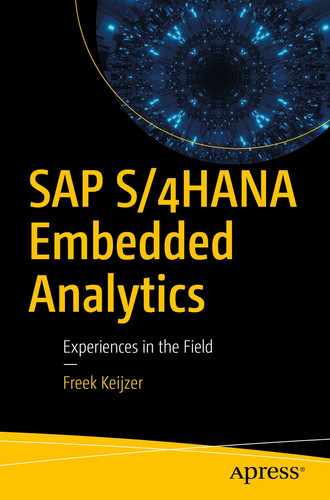SAP S/4HANA Embedded Analytics
Experiences in the Field
1st ed.
This Apress imprint is published by the registered company APress Media, LLC part of Springer Nature.
The registered company address is: 1 New York Plaza, New York, NY 10004, U.S.A.
This is not the first book to be written on the topic of SAP S/4HANA embedded analytics, and it will probably not be the last. The difference from other books on the topic is captured in the subtitle: Experiences in the Field. The book was written from a practical implementation perspective, and it focuses on functions that have proven themselves useful in the field.
The target audience of the book is broad—business users, consultants, developers—but that does not mean every chapter is equally interesting to every member of the target audience. Chapters 1 and 7 cover miscellaneous topics of interest to all readers. Chapters 2 to 6 are characterized by an increasing amount of work to obtain the presented analytics functions and also require an increasing level of technical expertise from the reader. Chapter 6 may well be the highlight of the book for developers, while at the same time can be skipped by business users.
As mentioned, Chapter 1, “Before the Work Starts,” covers miscellaneous introductory topics, preparing readers for the details of SAP S/4HANA embedded analytics. The chapter also introduces data modeling, different forms of cloud deployment, the Fiori user interface, SAP’s business intelligence product portfolio, and of course CDS views, which are the building blocks of SAP S/4HANA embedded analytics.
Chapter 2, “No Work: Use What Is Delivered,” does a deep-dive into the standard analytical content delivered with the SAP S/4HANA software. It starts off with an explanation of a certain aspect of Fiori: which tiles are shown to a user and how they are grouped. After that, the chapter focuses on finding, activating, and using SAP-delivered analytical apps. The chapter ends with my contribution to the never-ending battle against the “Excelification” of analytics.
Chapter 3, “Some Work: Smart Business Service,” presents a demo of SAP Smart Business Service, which is a KPI-based framework for the development of analytical apps. It has a codeless, menu-driven user interface, and it is targeted at business users and functional consultants.
The real thing in S/4HANA Embedded Analytics are objects named analytical queries. Chapter 4, “More Work: Building Analytical Queries Using Tiles,” describes how to build these objects in a software-as-a-service environment. The starting point for this type of development is creating SAP-delivered CDS views that can be explored using the Query Browser and View Browser tiles. For the development, you can apply the Custom CDS Views and Custom Analytical Queries tiles.
Chapter 5, “Most Work (Basic): Building Analytical Queries in an IDE,” and Chapter 6, “Most Work (Advanced): Building Analytical Queries in an IDE,” are an even deeper dive into the creation of analytical queries, but this time in an integrated development environment (IDE) connected to an on-premise S/4HANA system. Chapter 5 covers the basics such as connectivity between S/4HANA and the IDE, naming conventions, documentation including data lineage, and ABAP CDS. It also includes a real-life case study, where requirements and the data model are discussed, and all required layers of the data model are built from the bottom to the top including basic views, data integration, cube view, and query view. Chapter 6 covers diverse, more advanced topics such as custom master data views, complex logic, use of parameters and session variables, compatibility views, how to make data “less real time,” multilingual descriptions of field names, “jump to” functionality, how to create a dedicated tile for a query, data authorization, query performance, issues with transporting CDS-views, and Analysis for Office.
Finally, in Chapter 7, “Extensibility, OData, and Beyond,” other types of S/4HANA extensibility are addressed in case Embedded Analytics is not sufficient. The chapter also covers OData services, as well as Agile Development and DevOps in the context of analytics. The final section of the book outlines the ideal skillset for an embedded analytics expert.
Please note that I alone am responsible for the content of this book. Software vendor SAP and client Dutch Railways cooperated by providing graphs and allowing me to take system screenshots, but this much appreciated cooperation does not mean these companies are in any way responsible for what I have written.
Attaphon Predaboon, Pascal van Miltenburg, and Jeroen Keijzer, for doing an excellent job as technical reviewers.
Stan Keijsers, for creating the demo presented in Chapter 3. Thanks, Stan! Please notify me when you have a garden. I will mow your lawn for at least a year.
Yge Pars, for delivering specifications of the “Return List” case in Chapter 5.
Danny Linders, for being my travel companion during the journey into the world of ABAP CDS views in Eclipse.
SAP, for allowing me the use of some of its figures. Note that SAP is in no way responsible for the context in which these figures are presented.
Employers Atos, Ciber, and myBrand, and more than 50 clients, for allowing me to build up SAP business intelligence expertise in numerous diverse and interesting projects over a period of 21 years.
Clients Ciber (internal project), Pon, and Dutch Railways, for giving me the opportunity to work on various forms of S/4HANA Embedded Analytics in their projects.
MyBrand and Nederlandse Spoorwegen (Dutch Railways), for allowing me to take screenshots from their systems. Thanks to Stan Jilesen of Dutch Railways for checking the screenshots for sensitive information.
My family, Jacqueline, Annebel, and Rutger, and our daughter Karlijn, who inspired us from the day she was born and still continues to do so.

has a background in science (physics), industry (manufacturing, process industry), and ICT (SAP system integration), holding various project management, people management, and specialist positions. He has degrees in natural sciences (PhD) and information management (MIM). In 1996, he became involved in an SAP implementation, initially as an R/3 key user and later as an internal project leader, interim manager of the support organization, and (international) information manager. Since 2001, he has focused on SAP BI consultancy, working for three consultancy firms and more than 50 clients. His responsibilities as a consultant include product development, team competence development, sales support, and resourcing. Freek’s technical specialties include SAP business intelligence, HANA, NetWeaver, and ERP integration. His roles include project leader, lead consultant, business consultant (interim) manager, and Scrum master. Since 2015, Freek has been a brewer/owner of the Rubelijn craft beer brand.

He has led his team in business development and proof of concept as well as in the deployment of SAP and many other data analytics technologies for various local and global firms.

In 1998, Pascal completed his MBA at the University of Tel Aviv, majoring in international business management and with a minor in information systems. Subsequently Pascal started working as an SAP consultant specializing in finance and controlling, quickly expanding to several other ERP components that SAP supports. Because of this broad experience and interest, he has fulfilled the roles of integration manager and solution architect in many projects.
For the last few years, he has been responsible for the overall solution design in one of the largest recent S/4HANA greenfield implementations in the Netherlands. In this program, Pascal gave special attention to the implementation methodology, utilization of standard SAP, and, after careful consideration, extending functionality in the least disruptive method. S/4HANA Embedded Analytics constituted a large part of the solution scope.

is an SAP analytics consultant for myBrand in the Netherlands, specializing in SAP BW, SAP HANA, SAP BusinessObjects, and SAP Analytics Cloud. After completing his studies in business informatics (Saxion, 2003) and applied communication sciences (University of Twente, 2005), he joined KLM Royal Dutch Airlines to start his career in SAP consultancy. Specializing in SAP solution management and authorizations at first, he eventually chose to switch to analytics as a working field as this has always been his favorite area of interest. In 2014, Jeroen joined myBrand and started specializing in HANA database modeling and development. Since then, he worked on various projects to implement analytics solutions for a variety of customer fields including retail, financial lease, manufacturing, and real estate.
